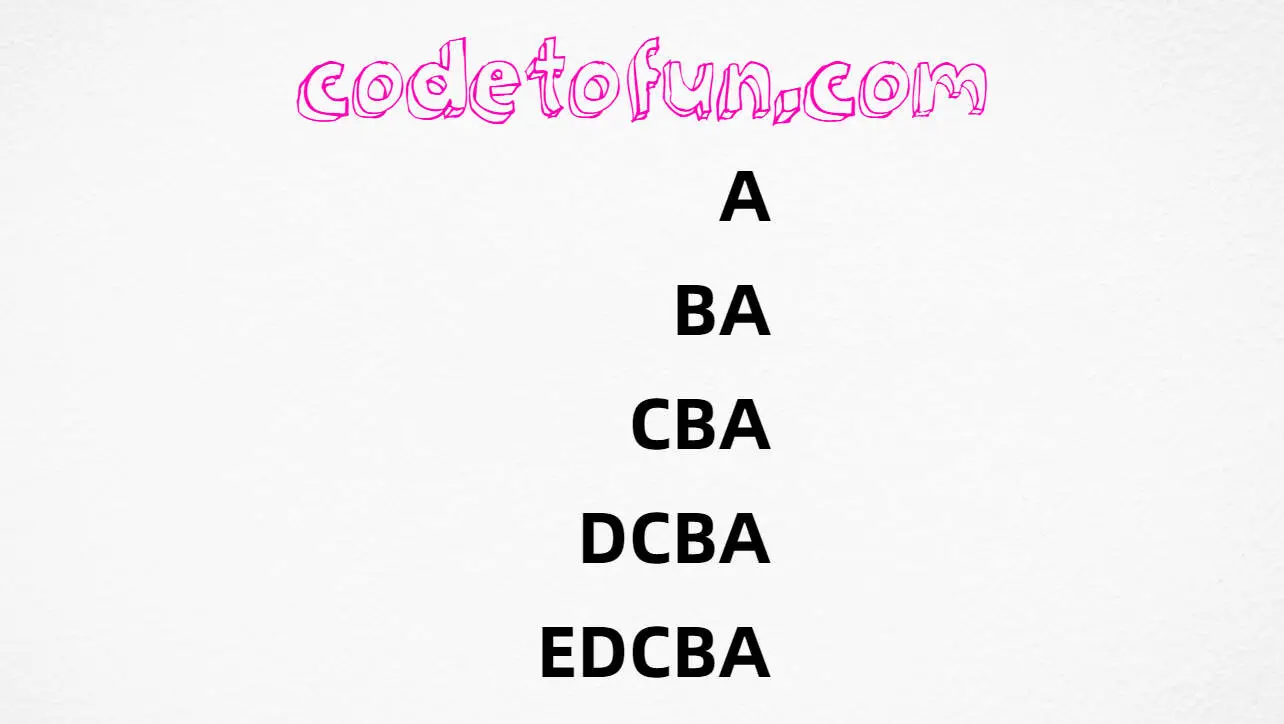
PHP Topics
- PHP Intro
- PHP String Functions
- PHP Interview Programs
- PHP Star Pattern
- PHP Number Pattern
- PHP Alphabet Pattern
- Alphabet Pattern 1
- Alphabet Pattern 2
- Alphabet Pattern 3
- Alphabet Pattern 4
- Alphabet Pattern 5
- Alphabet Pattern 6
- Alphabet Pattern 7
- Alphabet Pattern 8
- Alphabet Pattern 9
- Alphabet Pattern 10
- Alphabet Pattern 11
- Alphabet Pattern 12
- Alphabet Pattern 13
- Alphabet Pattern 14
- Alphabet Pattern 15
- Alphabet Pattern 16
- Alphabet Pattern 17
- Alphabet Pattern 18
- Alphabet Pattern 19
- Alphabet Pattern 20
- Alphabet Pattern 21
- Alphabet Pattern 22
- Alphabet Pattern 23
- Alphabet Pattern 24
- Alphabet Pattern 25
- Alphabet Pattern 26
- Alphabet Pattern 27
- Alphabet Pattern 28
- Alphabet Pattern 29
- Alphabet Pattern 30
- Alphabet Pattern 31
- Alphabet Pattern 32
- Alphabet Pattern 33
- Alphabet Pattern 34
PHP Alphabet Pattern 20

Photo Credit to CodeToFun
PHP Alphabet Pattern 20
Here`s a program that prints the above alphabet pattern using PHP Programming:
<?php
$alpha = range('A', 'Z');
for($i=0; $i<=4; $i++)
{
for($j=4; $j>=0; $j--)
{
if($j > $i)
echo "<div> </div>";
else
echo "<div>" . $alpha[$j] . "</div>";
}
echo "<br>";
}
?>💻 Testing the Program
When you run the above program, it will print the following output:
A BA CBA DCBA EDCBA
🧠 How the Program Works
Let's break down the logic behind the code:
- <?php: This opening tag indicates the start of a PHP code block.
- $alpha = range('A', 'Z');: This line creates an array called $alpha containing the uppercase letters of the English alphabet from 'A' to 'Z'.
- for($i=0; $i<=4; $i++): This initiates a for loop that will iterate five times, with the variable $i starting from 0 and increasing by 1 in each iteration, until it reaches 4.
- Inside the outer loop:
- for($j=4; $j>=0; $j--): This initiates an inner for loop that will iterate five times, with the variable $j starting from 4 and decreasing by 1 in each iteration, until it reaches 0.
- Inside the nested loops:
- if($j > $i): This is a conditional statement that checks whether the value of $j is greater than the value of $i. If this condition is true, it executes the following line.
- echo "<div> </div>";: If the condition is true, this line outputs an empty <div> element, which is used to create vertical space.
- else: If the condition in the if statement is false, this block of code is executed.
- echo "<div>" . $alpha[$j] . "</div>";: This line outputs a <div> element containing the letter from the $alpha array at the index $j. The index of $alpha corresponds to the current value of $j.
- echo "<br>";: After the inner loop finishes executing, this line outputs a line break <br> element, moving the output to the next line.
- After the outer loop and its nested loops complete, the program ends execution.
💯 Tips for Enhancement:
Explore the versatility of this pattern by adjusting its parameters. Whether you increase or decrease the size, tweak the spacing, or modify the characters used, each change opens up a world of possibilities, allowing you to customize and create your unique visual effects.
✔ Conclusion:
Creating visually appealing patterns is not only a fun endeavour but also a great way to enhance your programming or design skills. We hope this tutorial has inspired you to explore the world of creative coding. Share your creations with us, and let your imagination run wild!
🤗 Closing Call-to-Action:
We'd love to see your unique interpretations of the alphabet pattern. Share your creations in the comments below, and don't hesitate to reach out if you have any questions or suggestions for future tutorials. Happy coding!
👨💻 Join our Community:
Author

For over eight years, I worked as a full-stack web developer. Now, I have chosen my profession as a full-time blogger at codetofun.com.
Buy me a coffee to make codetofun.com free for everyone.
Buy me a CoffeeShare Your Findings to All
Recent Post in PHP














If you have any doubts regarding this article (PHP Alphabet Pattern 20) please comment here. I will help you immediately.